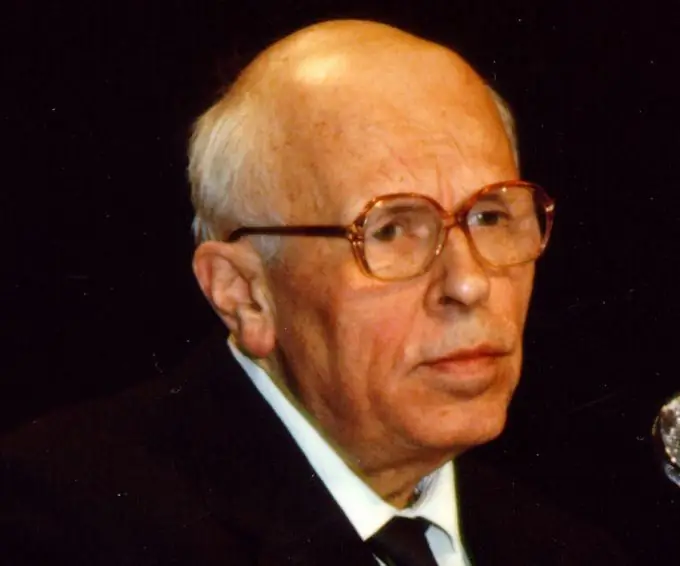- Author Antonio Harrison [email protected].
- Public 2023-12-16 07:44.
- Last modified 2025-01-22 21:44.
Andrei Dmitrievich Sakharov is a full member of the Russian Academy of Sciences, physicist, scientist, one of the creators of the hydrogen bomb. AD Sakharov was a People's Deputy of the USSR and a human rights activist. Nobel Peace Prize Laureate

Biography of Academician A. D. Sakharov
Andrey Dmitrievich Sakharov was born in the family of a scientist physicist and a housewife on May 21, 1921. Father, Dmitry Ivanovich, the son of a lawyer, had a musical and physical and mathematical education. While working, I wrote a collection of problems in physics. Mother, Ekaterina Alekseevna, military daughter and housewife. The constant presence of the mother and grandmother at home allowed the future academician to receive his primary education at home. He went to school only in the 7th grade. Home education has brought considerable benefit to Andrey, teaching him independence and ability to work. However, as a child, he suffered from a lack of communication, which caused some problems in the future.
His father helped him to finish school and get the necessary knowledge in physics and mathematics. In 1938, Andrei entered the Physics Faculty of Moscow State University, from which he graduated with honors. The young man refuses to study in graduate school and begins to work at a military plant, first in Kovrov, then in Ulyanovsk.
Scientific activity of Andrei Sakharov
Working at a military enterprise in Ulyanovsk allowed Sakharov to show himself as an outstanding scientist. At the factory, he created the first invention - a device for hardening armor-piercing cores. It was 1942. The Great Patriotic War was going on, and Sakharov applied for enrollment in the Soviet army. But he was denied for health reasons.
After the war, Andrei Dmitrievich returned to Moscow and again decided to continue his studies. He enters graduate school to the physicist E. I. Tammu and becomes his assistant. Andrey defended his Ph. D. thesis under the guidance of Tamm. In 1948 he began to work in a group for the creation of thermonuclear weapons.
The first test of a hydrogen bomb took place on August 12, 1953. At the same time, Sakharov defended his doctoral dissertation and became an academician. For his participation in the development of thermonuclear weapons, Academician Andrei Dmitrievich Sakharov was awarded the Medal of the Hero of Socialist Labor and the Stalin State Prize.
A. D. Sakharov's human rights activities
After a second test of a hydrogen bomb, which killed people, Sakharov changes his activities. Since the mid-1950s, A. D. Sakharov began to advocate the prohibition of the use and testing of nuclear weapons. Andrei Dmitrievich took part in the development of the draft treaty "On the prohibition of nuclear weapons testing in three environments."
Under Nikita Khrushchev, Sakharov's interests were no longer limited to nuclear weapons. He opposed the reform of education, openly criticizing the policies of the Soviet leader. The academician opposes Lysenko, considering him responsible for all the problems of Soviet science. Writes a letter to the congress, opposing the rehabilitation of Stalin. All these performances did not go unnoticed. At that time, the struggle against dissidents was widespread in the Soviet Union.
In 1967, Andrei Dmitrievich sent a letter to Leonid Ilyich Brezhnev asking for the protection of four dissidents. This marked the end of the scientist's career. He was stripped of all his posts and sent to work as a senior researcher. Sakharov opposed censorship, political trials and trials of dissidents. As a result, he was suspended from work on nuclear weapons. However, his human rights activities did not stop.
Since the Soviet censorship did not allow Sakharov to fully express his opinion, he began to publish books and brochures abroad. The academician condemns mass terror and Stalinist repressions, persecutions of cultural and art workers. In October 1975, Andrei Dmitrievich Sakharov was awarded the Nobel Peace Prize.
Personal life and family
During the years of his life and work, Academician Sakharov was married twice. The first wife of Andrei Dmitrievich was Klavdia Alekseevna Vikhireva, who bore him three children. Due to the war and caring for children, she was unable to complete her education and get the necessary position at a military plant in Ulyanovsk. Klavdia Alekseevna died in March 1969.
The second wife of the academician, Elena Bonner, whom Sakharov met while abroad. She became his support in all endeavors in the struggle for human rights. E. Bonner supported her husband in his political activities, was with him in exile in Gorky. Sakharov's complete rehabilitation took place in 1986. He was able to return to Moscow and continue working.
Sakharov devoted the last months of his life to work on the drafting of the Constitution of the USSR. He was elected a people's deputy and participated in the first congress. An outstanding scientist died of cardiac arrest on December 14, 1989.






